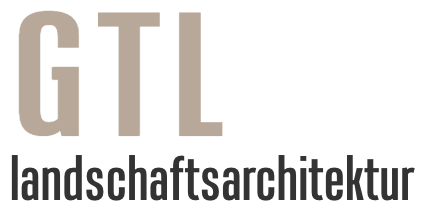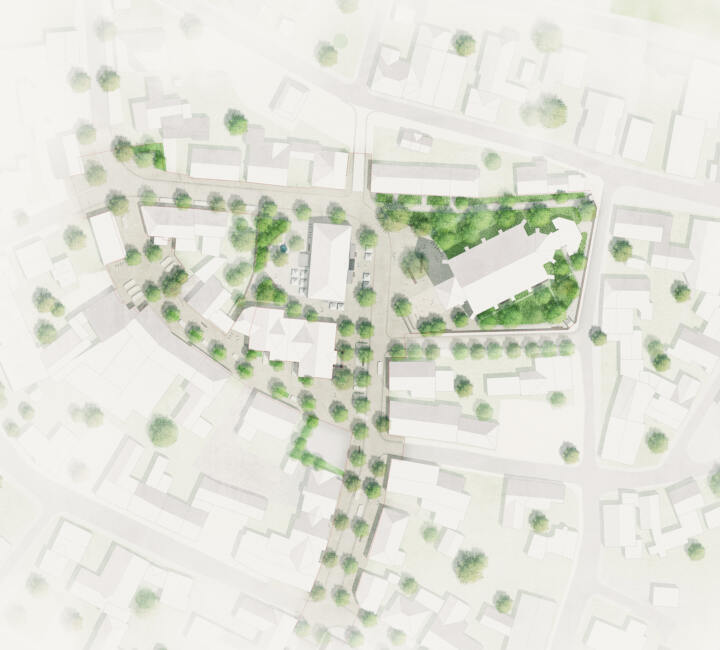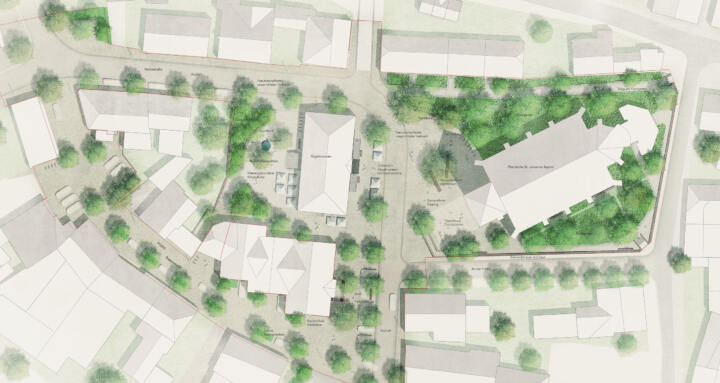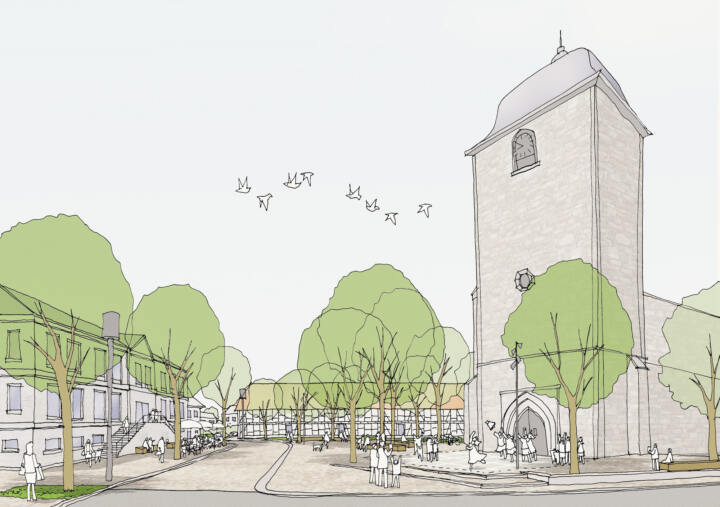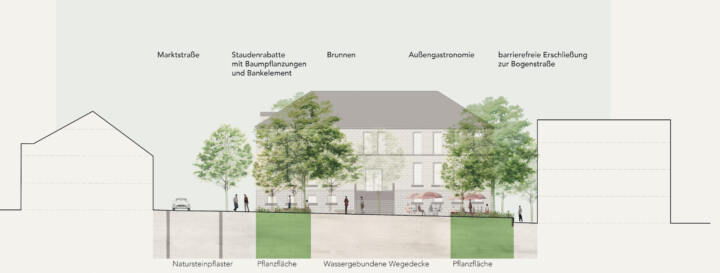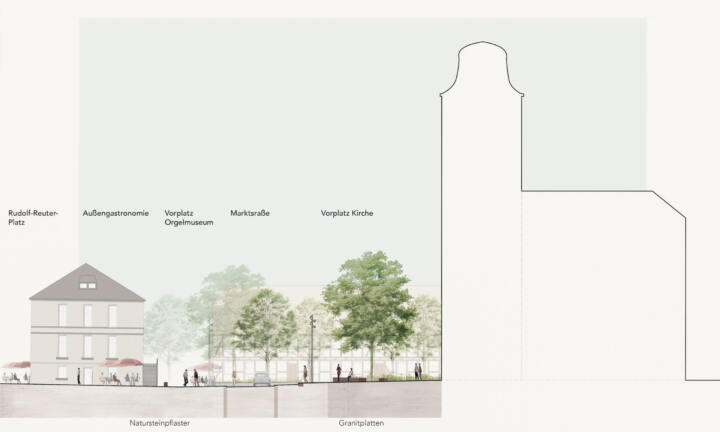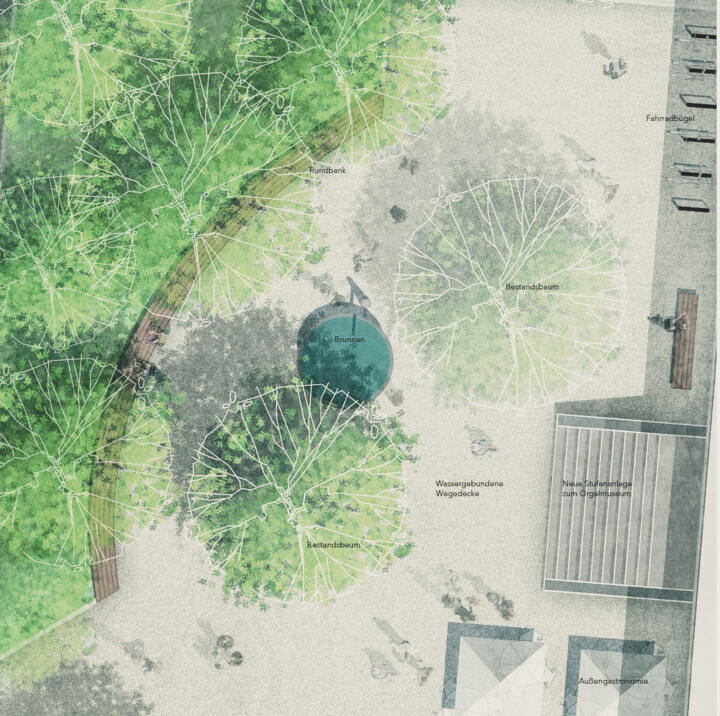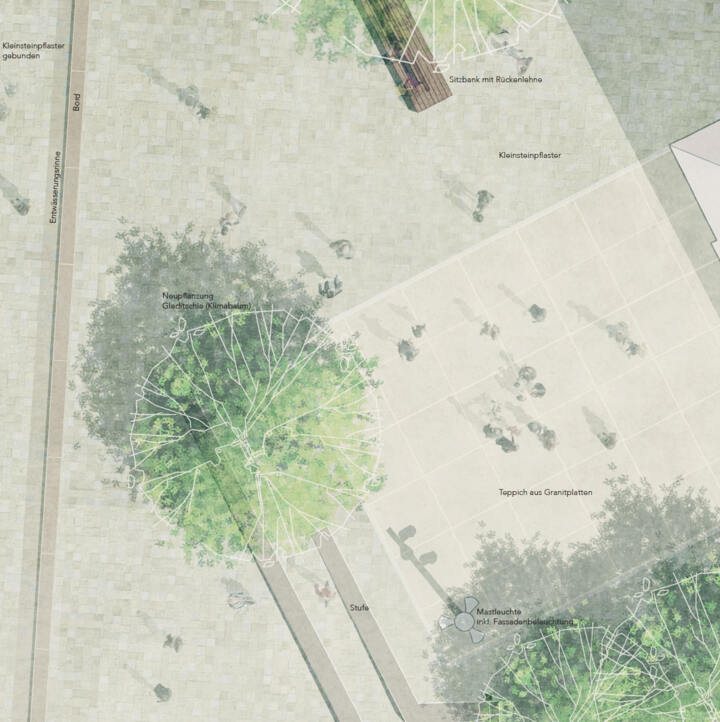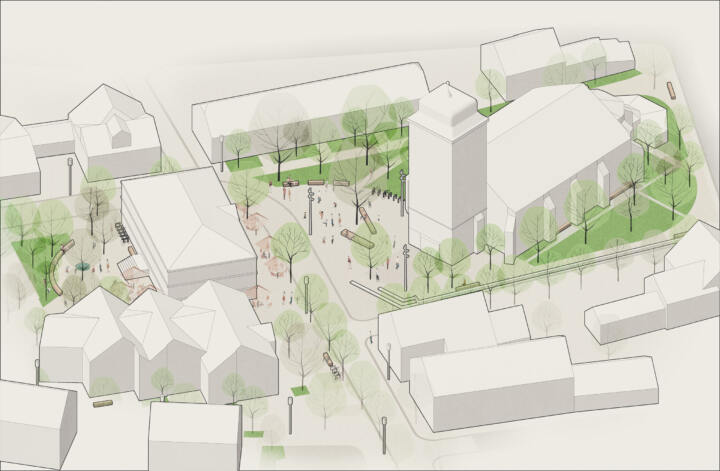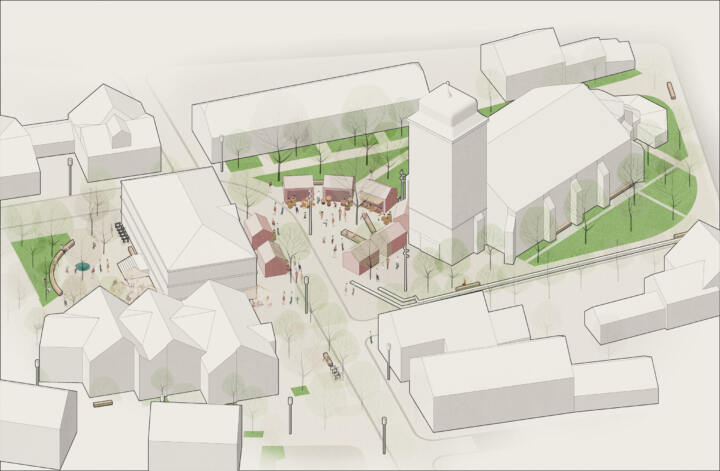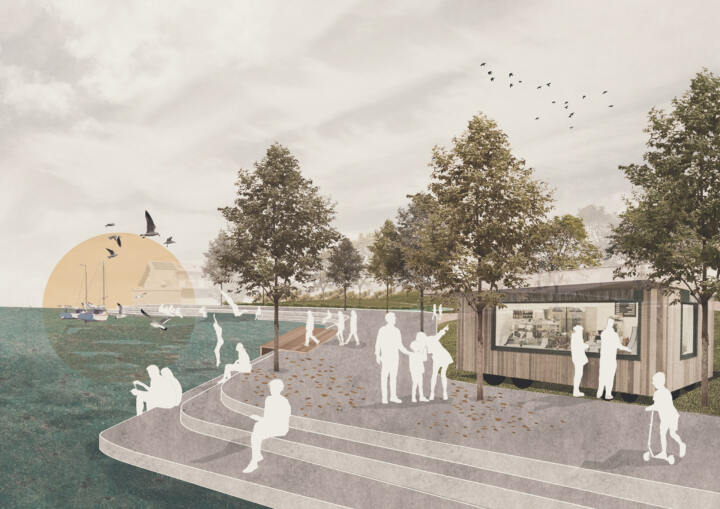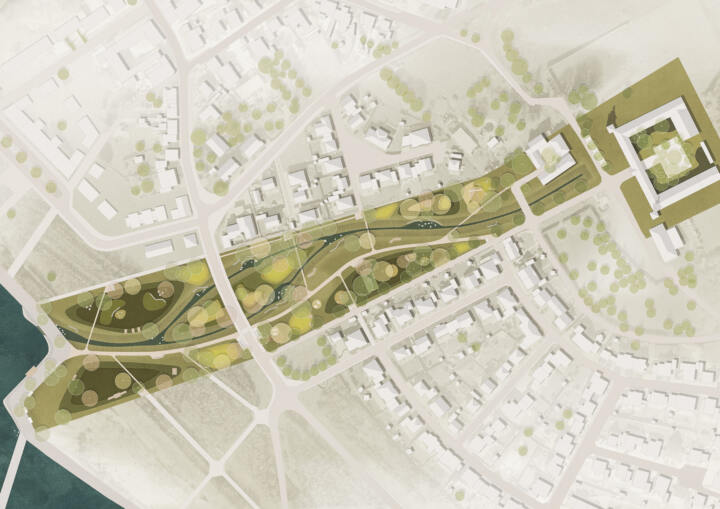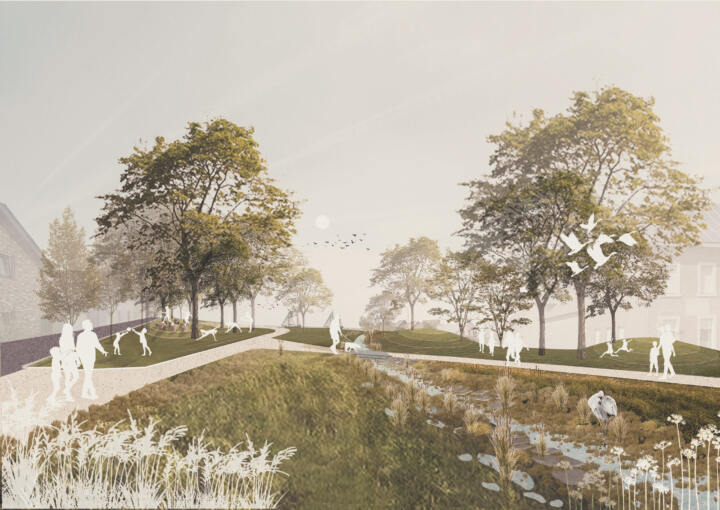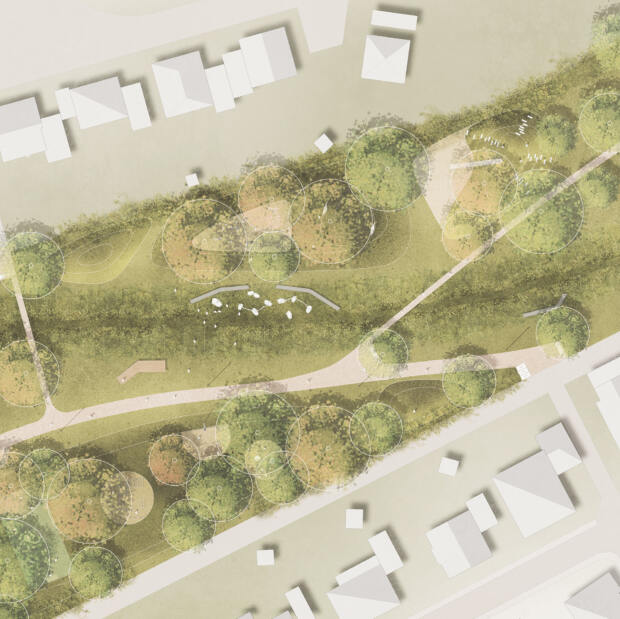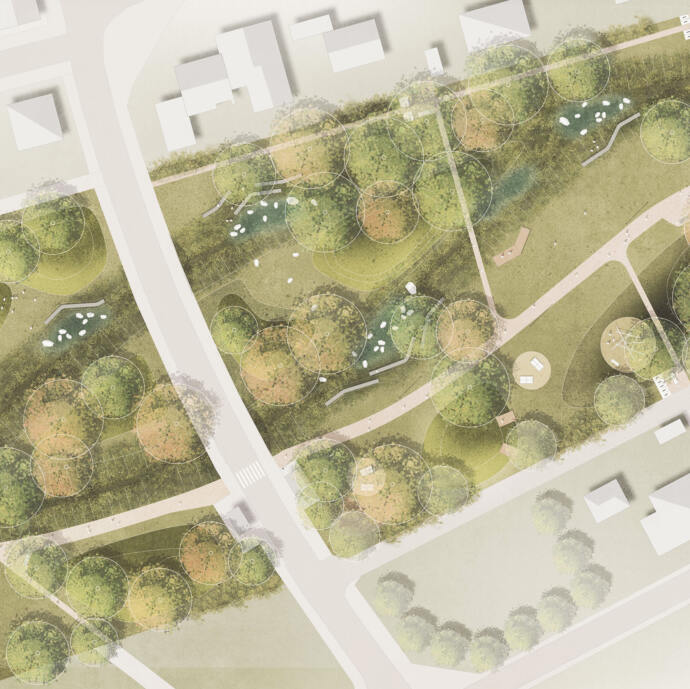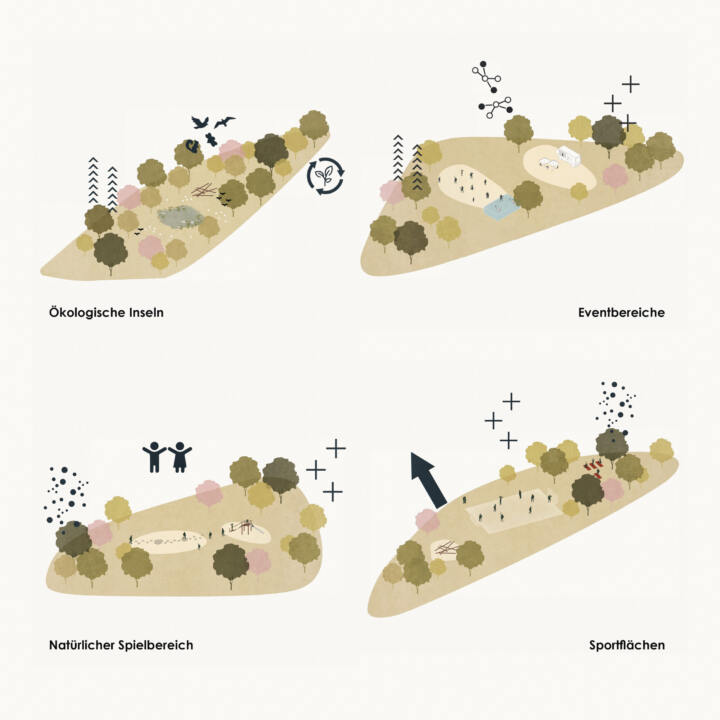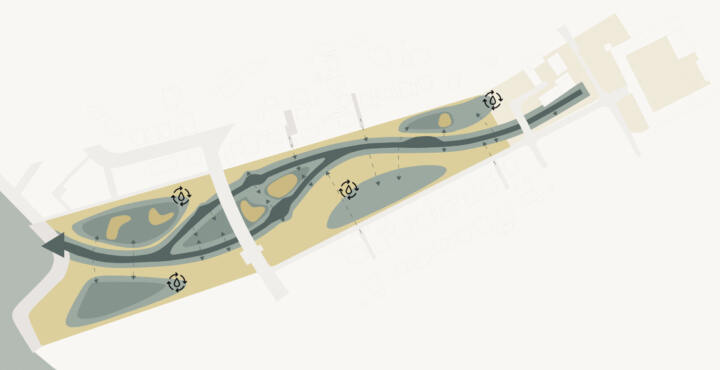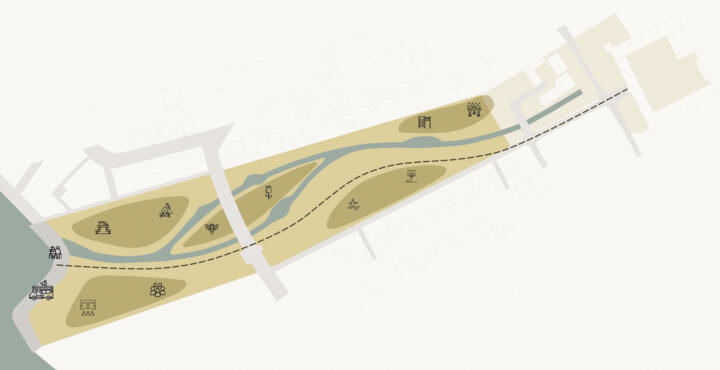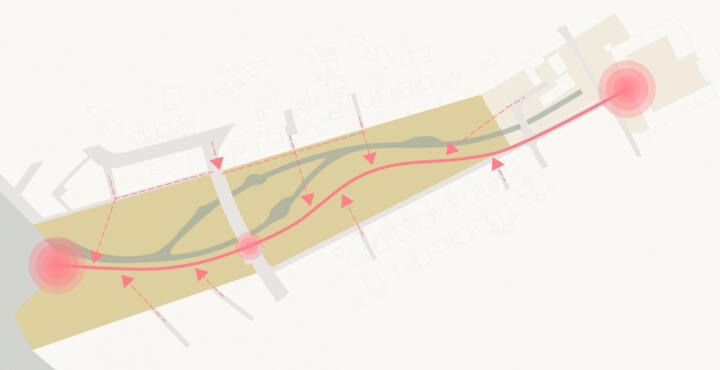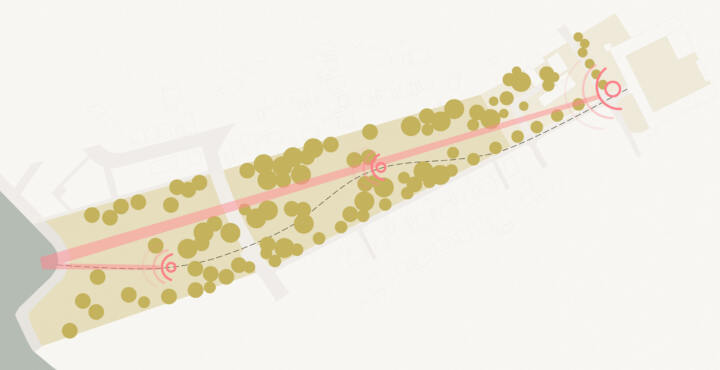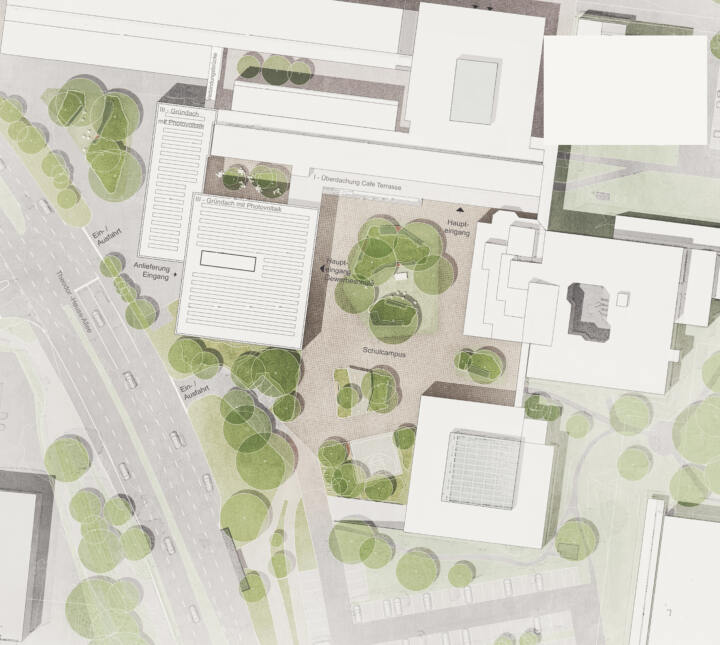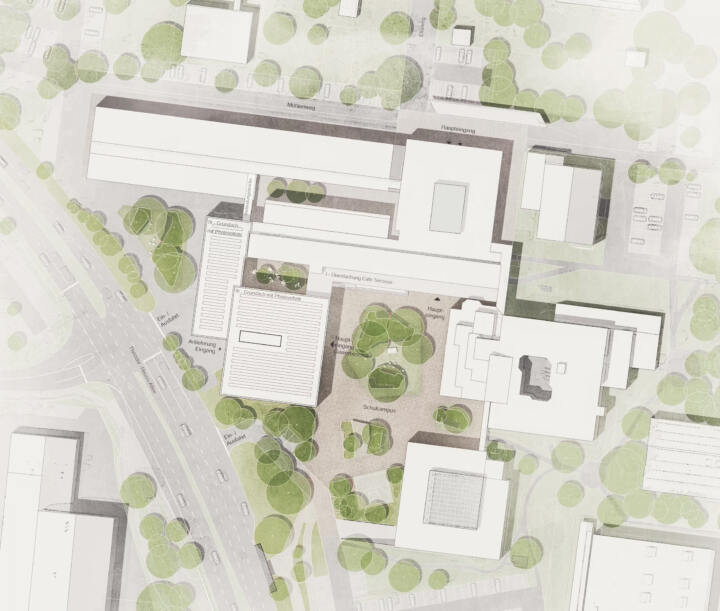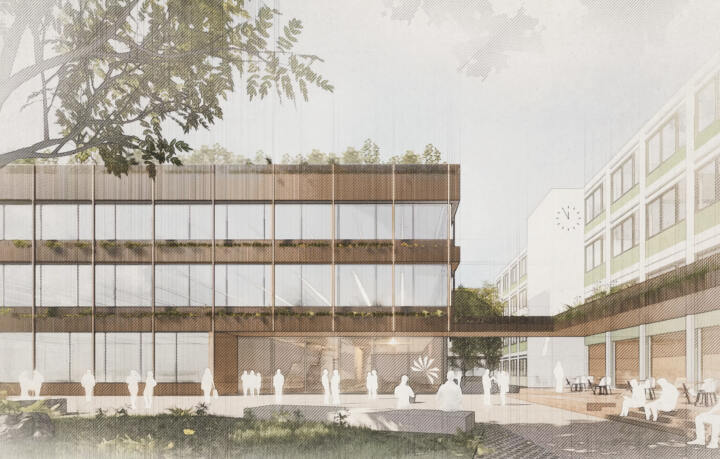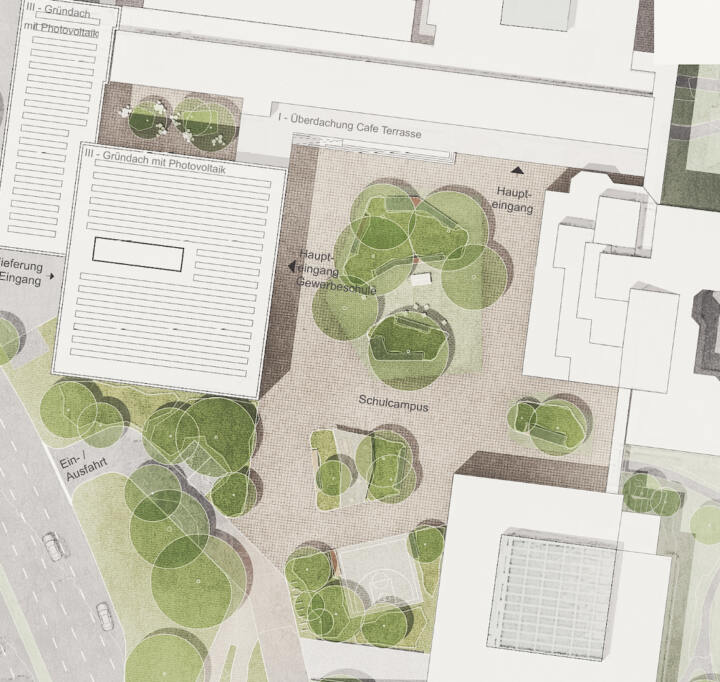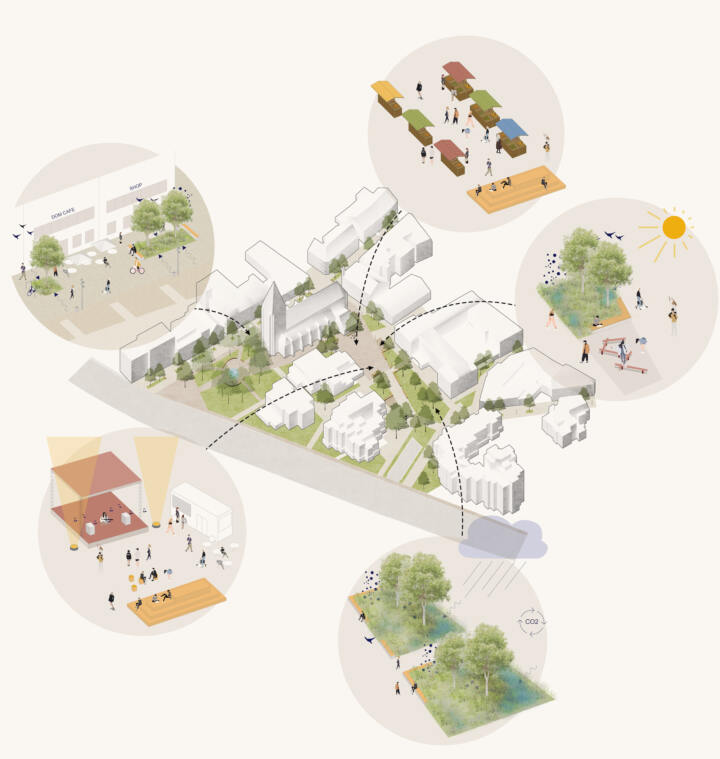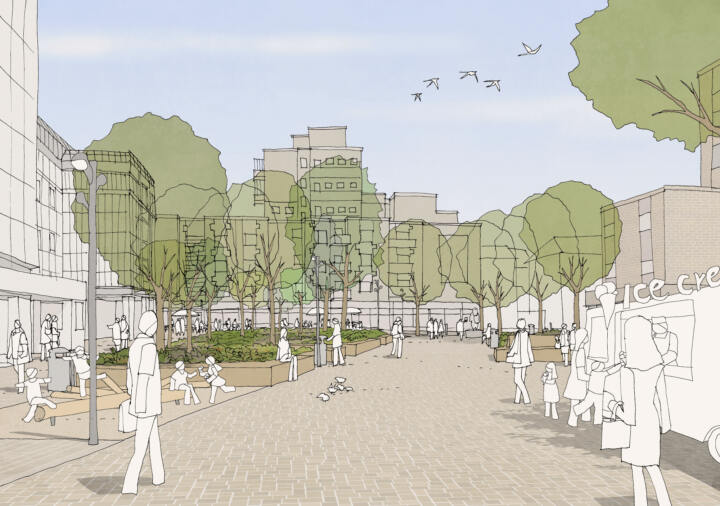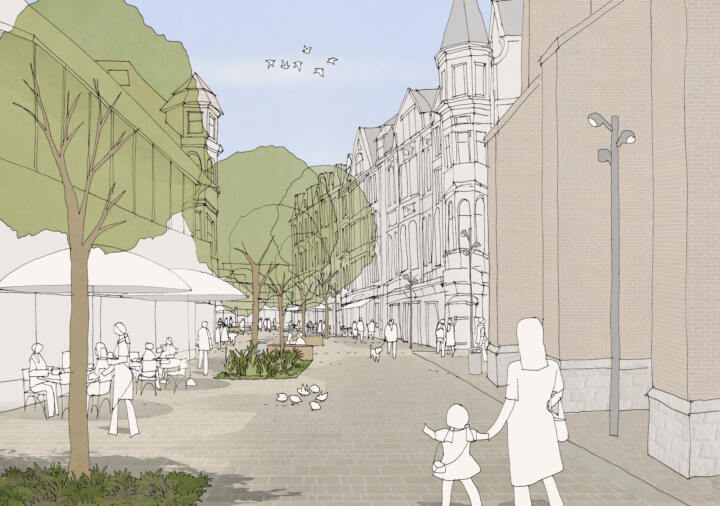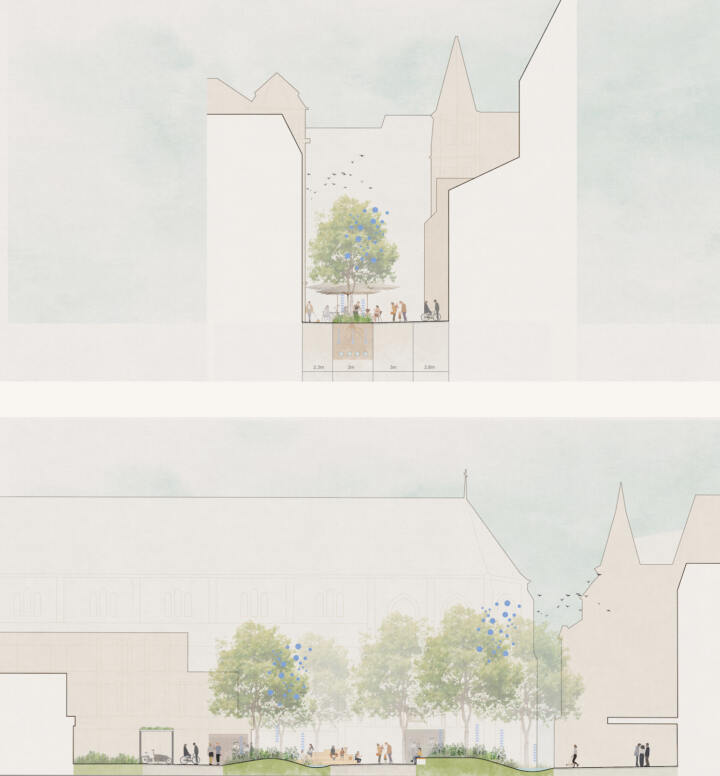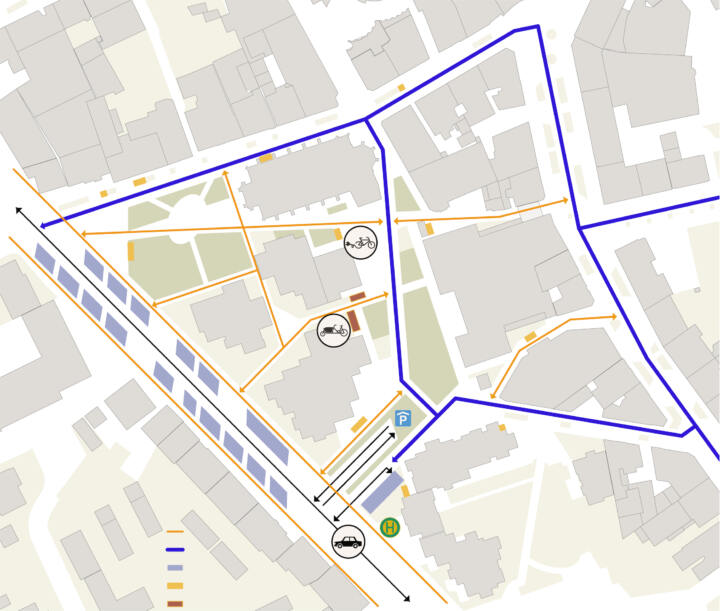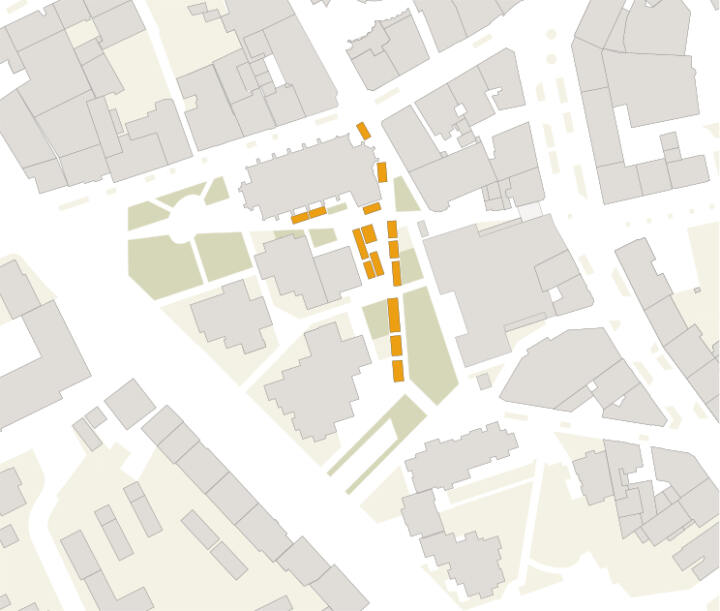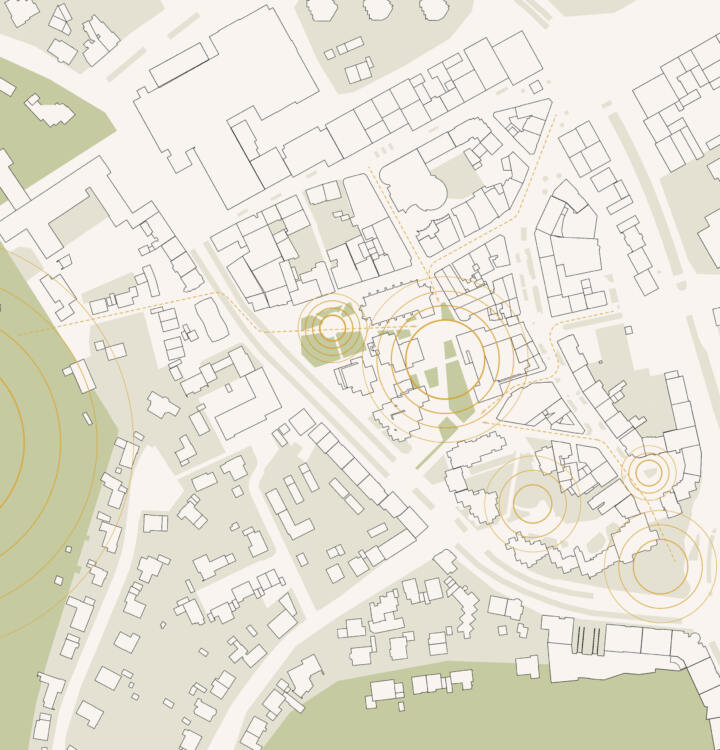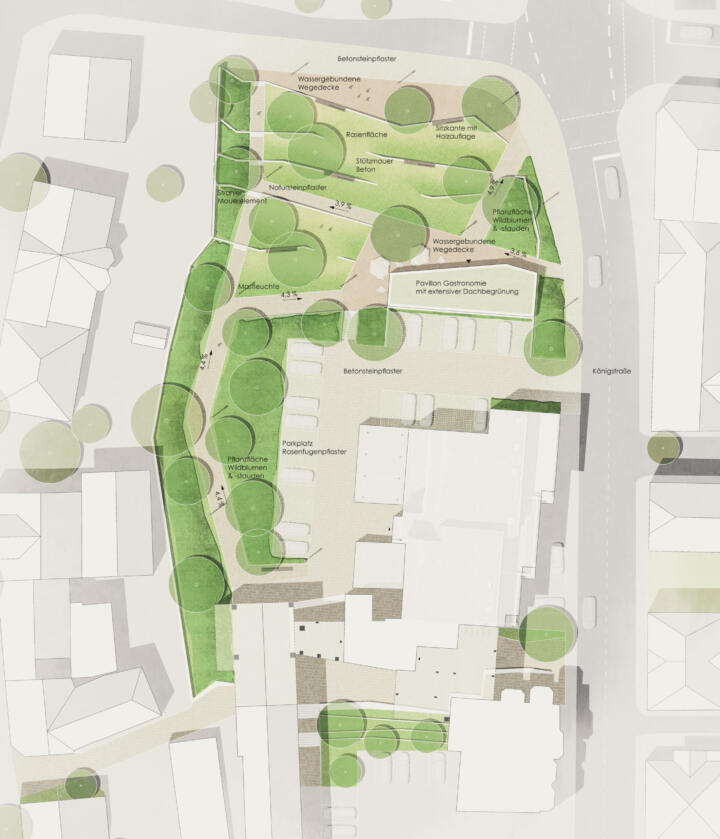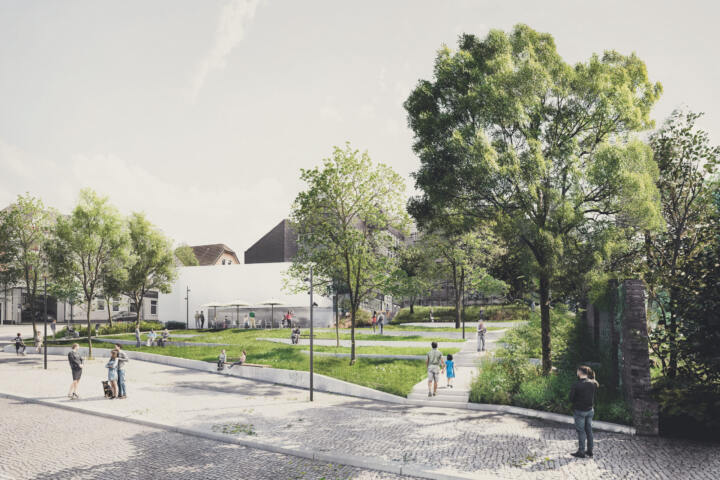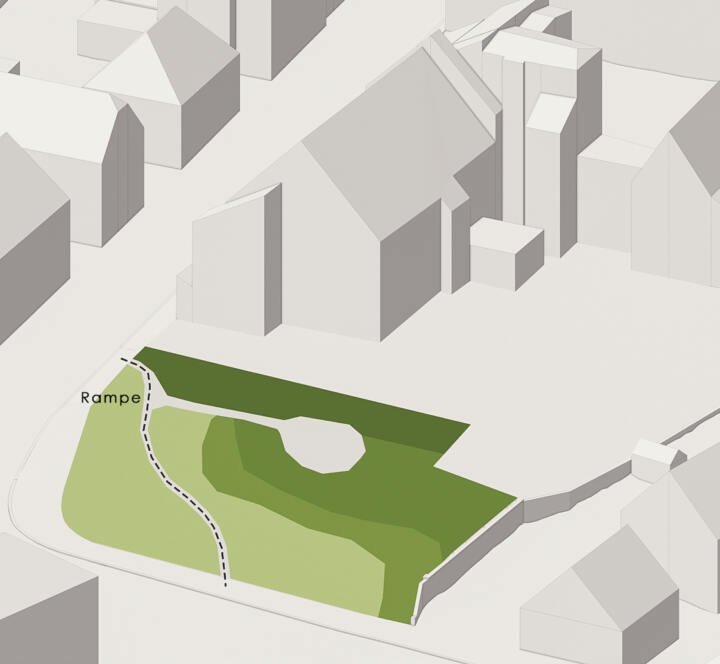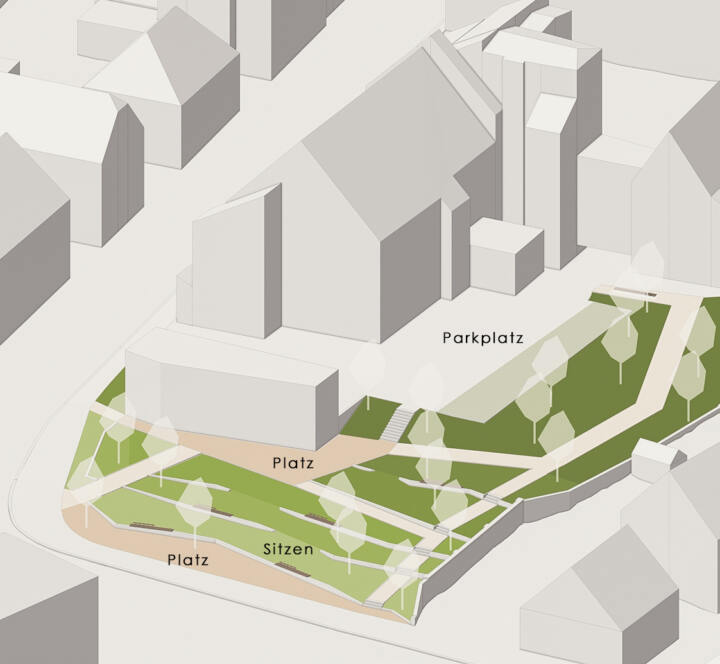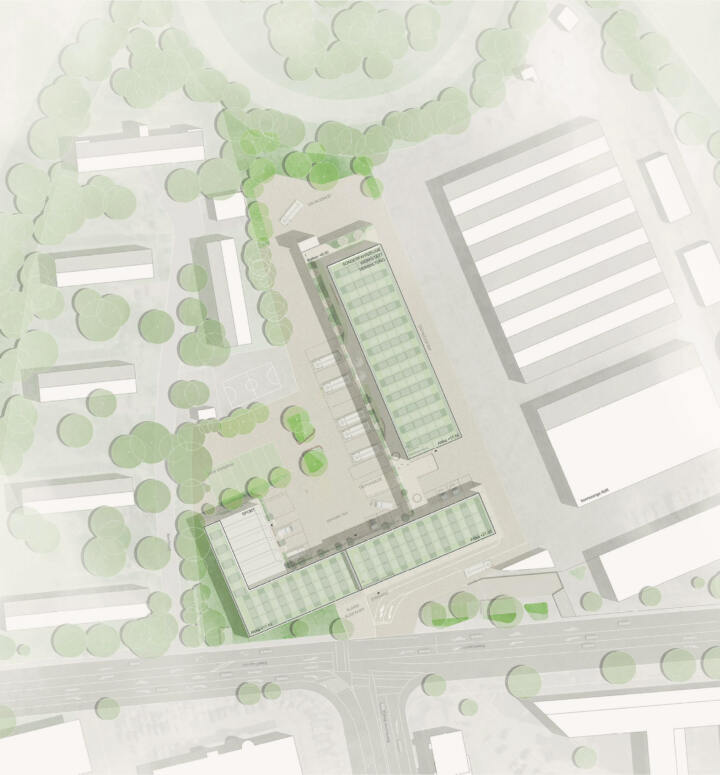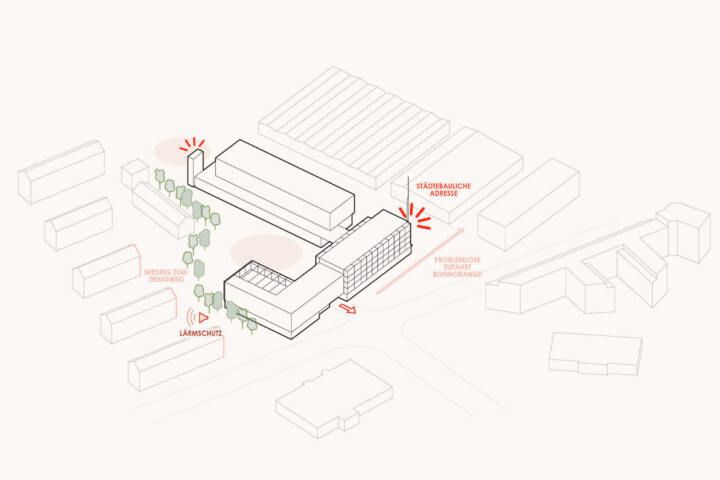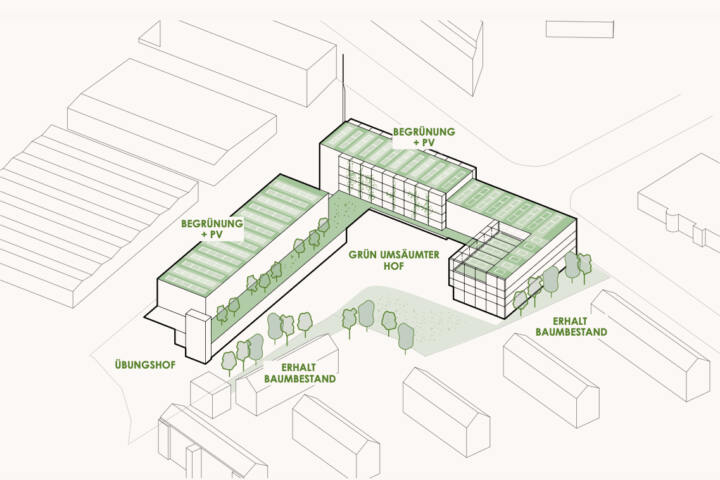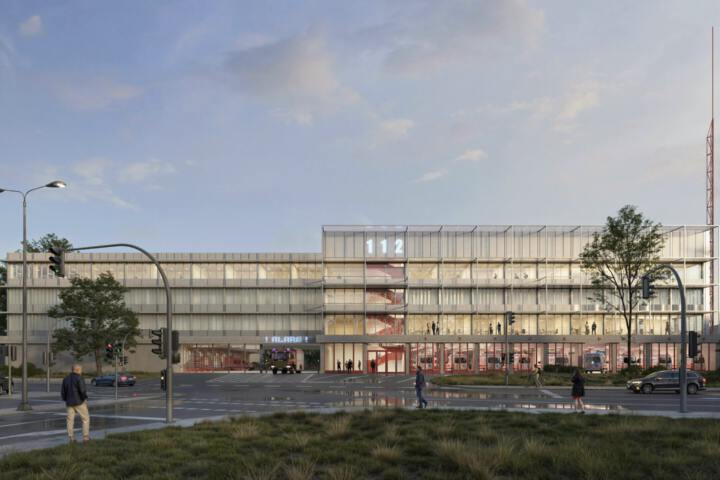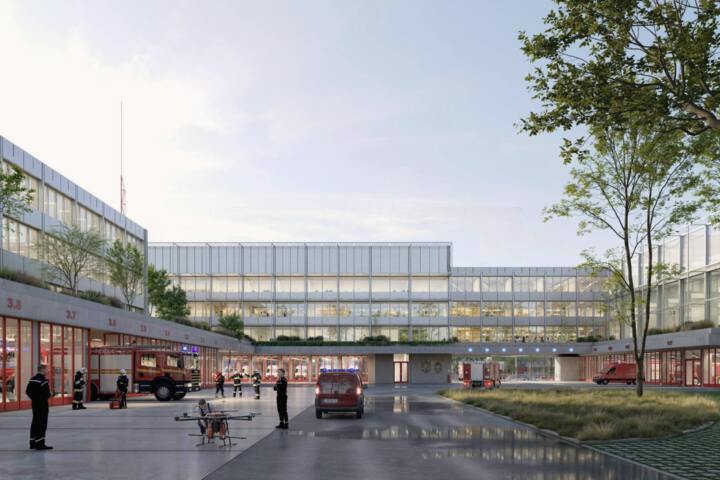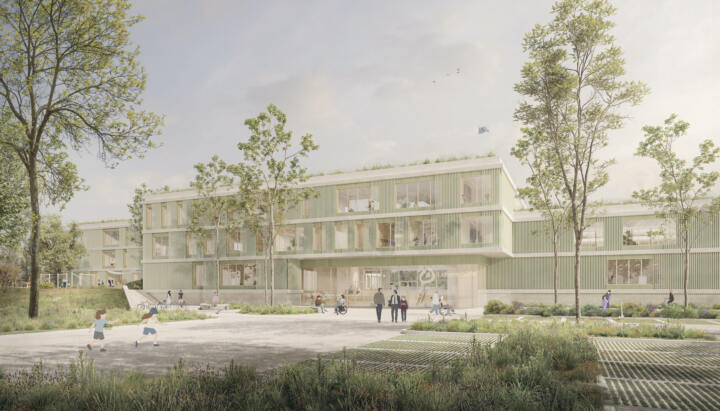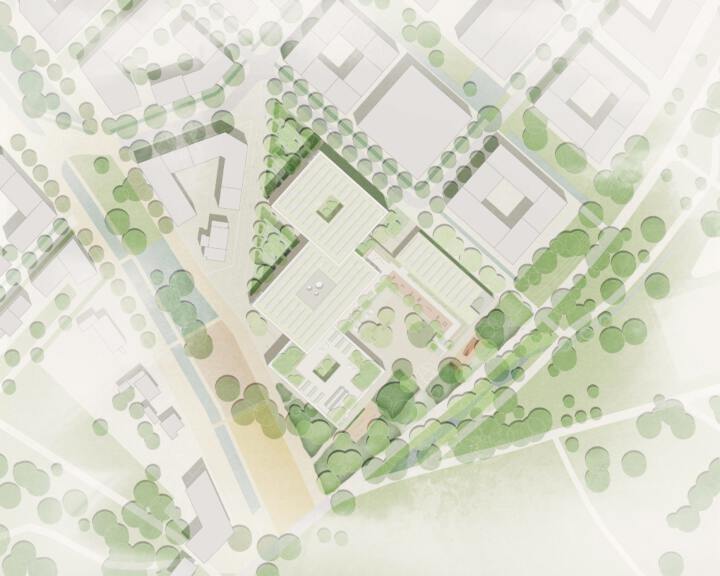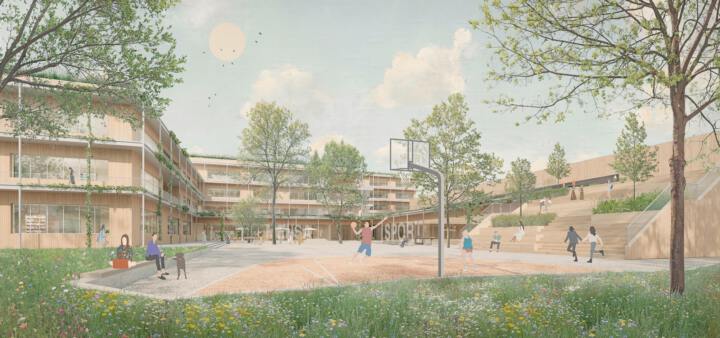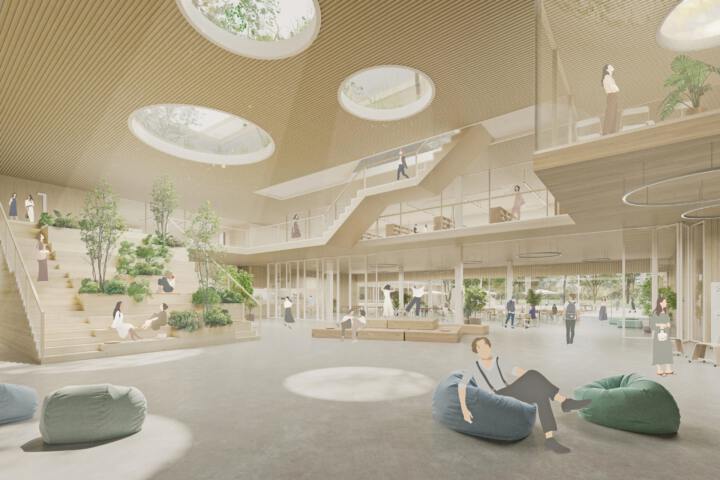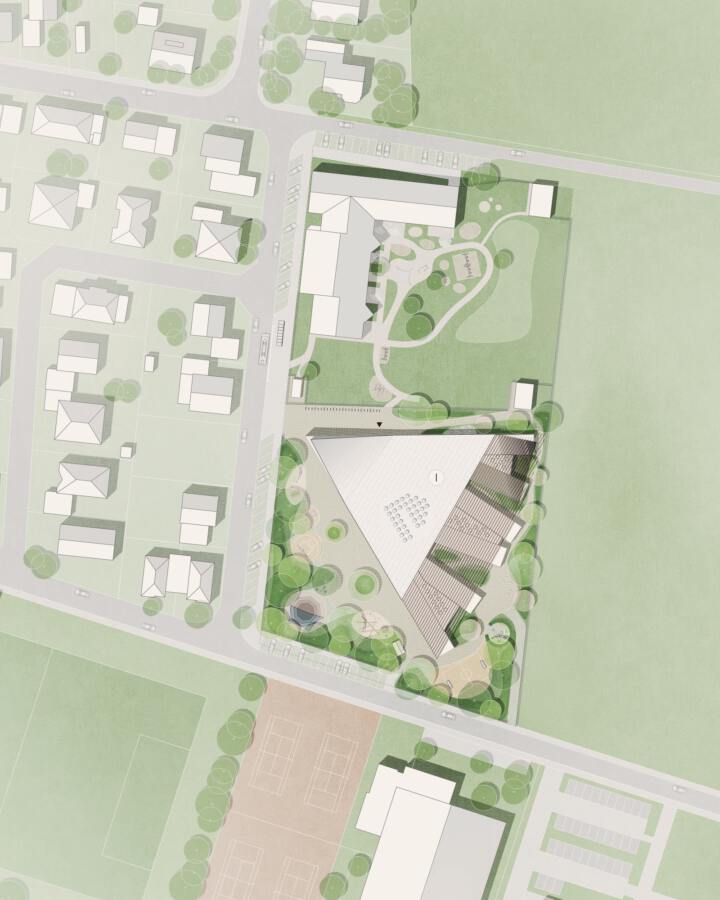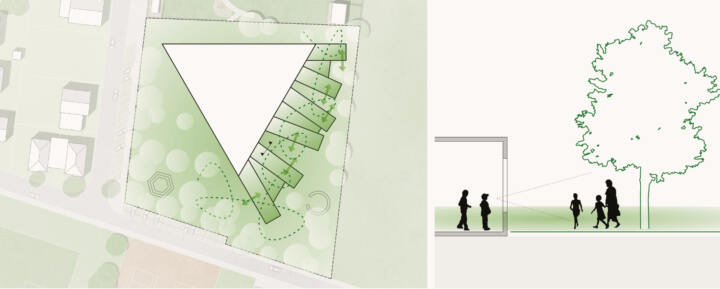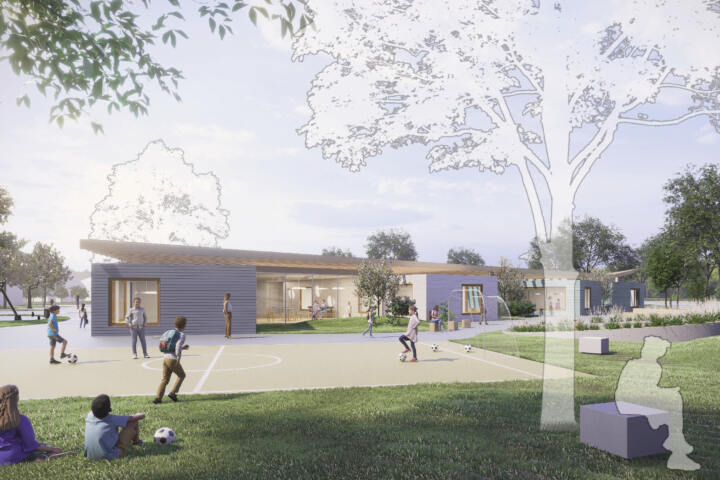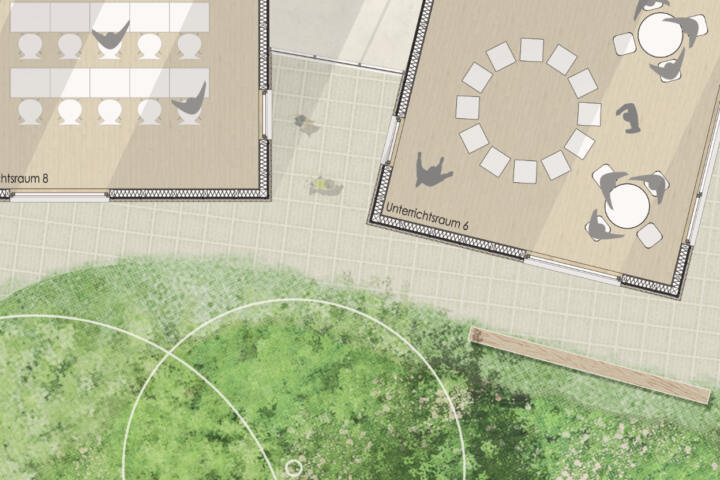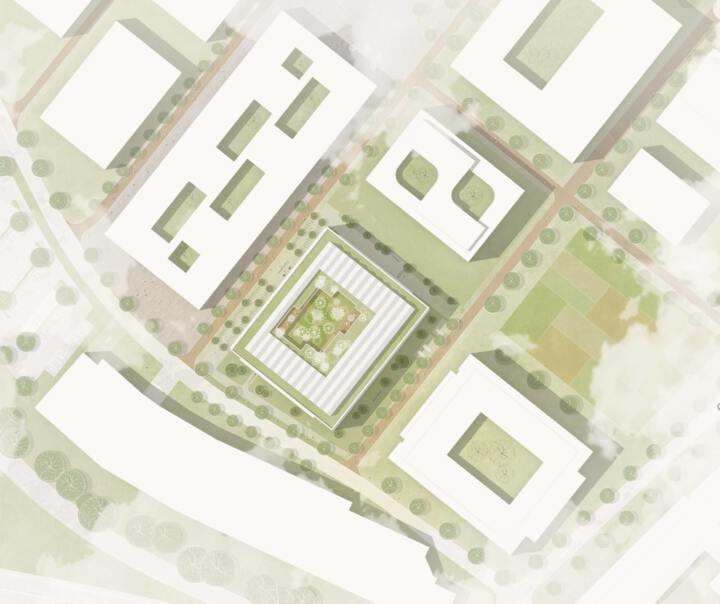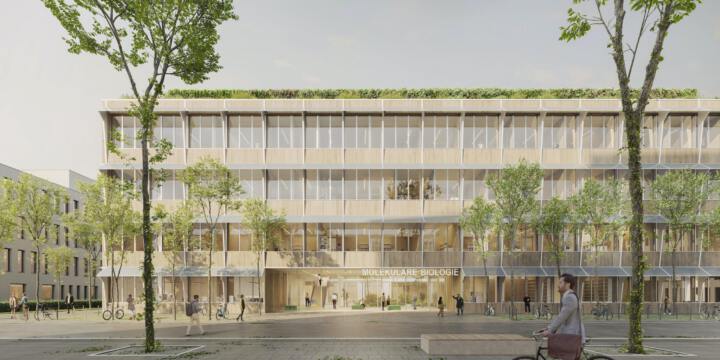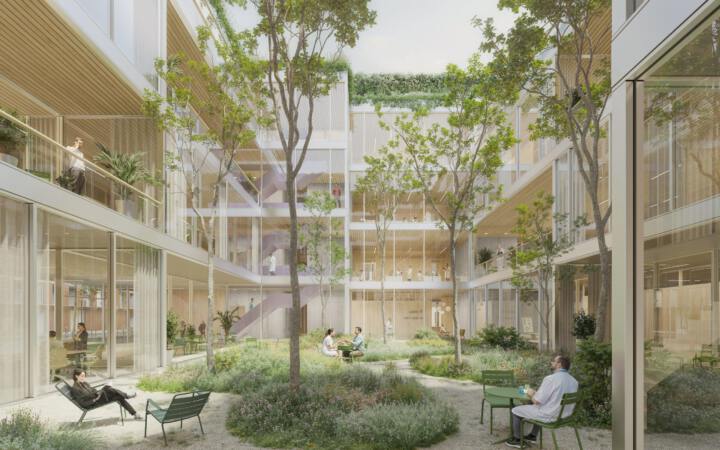City Centre | Borgentreich
3. Prize | City Centre
Borgentreich
A new centre for the organ city
The design concept for the town centre area of the organ town of Borgentreich envisages an upgrading of the historically significant ensemble of church, organ museum and the surrounding half-timbered houses. A strong, green framework will create a central square where the church and the organ museum are located, thus creating a new centre that is appropriate to the location. This square offers space for intergenerational stays, festivals, markets and meetings in front of the church. Appropriate shading and evaporation areas and the use of light-coloured materials will create a climate-adapted urban space.
In the existing building, the organ museum and the church are located on different sides of the street without any connection to each other. There is also a lack of spatial edges around the buildings that would define a common space. By creating a green framework, the necessary boundaries are created. The intensive green framework also forms a sustainable green space within the city. Additional trees will be planted to provide shade and retain moisture in order to minimise the heating of the open spaces in summer. The existing lawns around the church will be transformed into a church garden with herbaceous areas and shrubs. This will allow much more rainwater to seep away and evaporate. When selecting plants, a variety of species is taken into account so that plants are always in bloom throughout the year and thus provide food for insects. At the same time, the plants are robust against longer periods of drought in the summer months. The existing trees will be integrated into the new structure. Individual benches along the church invite visitors to linger in the new church garden.
The open and free square created within the lush, green framework forms the new ‘heart’ of Borgentreich’s town centre. The square is divided into three areas – a church forecourt, a small central town square that extends in front of the organ museum and a further, more secluded square behind the museum. The direct entrance area of the church will have a carpet of large-format, used natural stone slabs. Here, people can stand in the trellis for weddings and socialise after church services. At the end of the carpet, the existing wall to the south merges into two steps that lead down to the street. This further defines and accentuates the church forecourt. Thanks to the natural topography of the square, the church can be accessed barrier-free via the square without any structural installations.
The new small stone paving made of natural stone connects the square areas across the street and draws them together into a single unit. Motorised traffic is guided across the square and sensitised to the use of the square by the visual and tactile change in material.
By slightly reducing the width of the carriageway in favour of the open space, a large, appropriate area is created in front of the organ museum. The space can be used as a place to stay and for catering. Large benches, some with backrests, will be placed around the existing tree in the centre of the square to create a spacious recreation area. The tree is integrated into the paved square with an open tree disc. A space for markets and festivals will be created around the central element to enliven the city centre square. The square will be furnished discreetly and appropriately for the location.
The furniture is made from certified wood and regionally produced materials to avoid long delivery routes. Passing the organ museum on the side, you reach the third area. The green frame also surrounds this area with a lush green back. The square will have a water-bound path surface with light-coloured litter, setting it apart from the central town square in terms of design and giving it its own identity. The existing trees will also be integrated into the new square in order to create large crowns with appropriate shade. A fountain enlivens the small square and provides a pleasant soundscape. The catering facilities are distributed around three sides of the organ museum and thus enliven the adjacent open spaces.
The street space will be massively upgraded with new tree planting. In both Bogenstraße and Marktstraße, the existing motif of the row of trees will be supplemented and completed by new plantings. This will give the street an important green atmosphere. Climate trees suitable for the new challenges in the urban climate will be planted. All new tree plantings will have a tree trench in which the rainwater from the pavements and the street will be collected and seeped away. At the same time, additional water is available to the tree in the event of prolonged drought. The existing tree plantings will be given an open, planted tree disc. The road cross-section will be reduced slightly to create more space for the peripheral areas. The width required for buses to pass each other will be maintained. This will create more space for pedestrians and stationary traffic and give the trees enough room to grow. The new trees will noticeably improve the urban climate, as the shade they cast will reduce the heating of the paved areas and any water that accumulates will be retained in the green areas, where it can seep away and evaporate. The market street will be marked by a low kerb and an open drainage trough.
The redesign gives Bogenstrasse an open, green character. The rainwater that accumulates here runs into the green tree discs of the single-row tree planting, where it can seep away and evaporate. The carriageway itself is only discreetly defined by marker nails. The pavement extends across the entire open space and creates a generous road space in which all road users are equally entitled to use.
Parking spaces for bicycles and cars are created between the tree plantings. Additional seating elements invite people to linger and enliven the street space. The lighting supports the design concept with different intensities. The street lighting will be continued as in the existing design. The new central town square between the church and the museum will also be given special lighting, which will make the new square a single entity even in the twilight and evening hours. The church garden and Rudolf-Reuter-Platz will be fitted with more discreet bollard luminaires.
The design concept, proportions and furnishings are intended to emphasise the character of the small town square. Robust, green and multifunctional, it will be available to residents as a new centre in the future.
En route to the lake | Inden-Schophoven
3. Prize | En route to the lake
Inden-Schophoven
Inden Schophoven’s new green heart.
Open space concept ❘ Over the coming years the entire surrounding area is due to undergo major transformation. An expansive industrial zone, currently inaccessible, will give way to an extensive recreational area with a lake, and this will be made accessible to the public. This will mean a radical change too for Inden Schophoven. This transformation offers a huge opportunity for sustainable development, since the whole region will not only be facing substantial demands due to the change in utilisation, but also climate change. Our design responds to both these key factors. The future park will become part of the region’s tourism concept and at the same time provide a sustainable local recreation area with blue-green infrastructure, while also creating a vista stretching from the Müllenark estate to the lake. Alongside the design for the park, the Müllenark estate will also be incorporated into the project. Here, in future, the focus will be on tourism with the creation of a green inner courtyard incorporating comfortable seating areas for both gastronomy and hotel guests.
The blue-green ribbon ❘ The park stretches from the Müllenark estate to the edge of the future lake. A meandering path connects these two places in a natural way. The path is flanked by a similarly curved retention basin, which splits as it reaches the lake, forming an island. The concept envisages not only the collection, infiltration and evaporation of rainwater within the park grounds, but also channelling rainwater from the surrounding publicly accessible areas into the park and then into the retention basin. Following heavy rainfall, this will create a watercourse leading into the lake. During periods of normal rainfall, individual puddles will form within the trough thus producing constant fluctuation between a water-bearing depression and a dry, utilisable hollow. A selection of resilient plants emphasises precisely these features. In addition to the central depression, some of the remaining areas are also slightly deepened, so they too can serve as retention areas during periods of heavy rainfall.
Modelling ❘ The entire park area is modelled according to these demands and uses, with the principal aim of ensuring all materials remain on site. Excavated spoil from the depression will be employed to form small hills for play and relaxation, or landscaped with plants. The new island will also use this spoil to form it and build it up. Here, intensive greening complete with nesting and nourishing shrubs and insect hotels provides a refuge for animals.
Resources and planting ❘ In selecting materials, emphasis has been placed on the responsible use of resources. Great importance is attached to ensuring short supply routes, using local materials and CO2-neutral forms of production. The extent of paved areas is deliberately kept to a minimum. It is only the meandering paths and the access routes through the park that have a water-permeable surface, whereby the top layer is strewn with a local gravel mix. The area next to the lake will be paved in keeping with the overall plan for the lake promenade. The steps in front are made of prefabricated concrete elements, providing an attractive place to linger right by the water. Furniture and play equipment in the park will be manufactured from certified, durable wood. Planting in the park is deliberately varied, with intensively planted areas alternating with open lawns and meadows. Towards the periphery, areas become more intensively planted. Not only do the various tree types stand closer together, they are also underplanted with shrubs. These are nourishing shrubs and thus provide habitats for animals. In selecting the plants, careful thought has been given to species diversity and sustainability, with a view to increasing biodiversity in the park.
Promenade and transition to lake ❘ The development of Site 2, located between Schlichstrasse and the future lake, will take place in several stages. In the next few years, the existing completely greened shielding wall will be preserved. This area will only be accessible via a simple network of paths. The meandering path through the park, leading from the Müllenark estate continues as a smaller path over the shielding wall and terminates in a viewing platform from which visitors can trace the area’s evolution – from open-cast mine to lake – on display boards highlighting this transformation. Two temporary areas on the shielding wall itself, invite visitors to linger under the trees. To mark the access to the emerging park, troughs already extend under the road as far as the embankment, so rainwater can be captured directly. In order to later merge these two sites into a single park and to create both a visual axis and a hydraulic engineering connection from the Müllenark estate to the lake, the existing shielding wall will be demolished.
Schlichstrasse ❘ A zebra crossing is being installed so that visitors can cross Schlichstrasse safely and move easily between one side of the park and the other.
Lighting concept ❘ Lighting is designed to structure the night-time atmosphere and ensure visitors’ safety. Dark corners and potential danger spots will be illuminated. This will encourage people to use the park during the evening hours and help create a feeling of security. To prevent vandalism, a sufficient number of high mast lights will be provided at regular intervals equipped with energy-saving LED luminaires, which not only protect the environment, but also reduce running costs. Park lighting is also designed to be respectful of the surroundings and prevent any disturbance to wildlife.
Workshops Ferdinand-von-Steinbeis-School | Tuttlingen
Recognition | Workshops Ferdinand-von-Steinbeis-School
Tuttlingen
In Collaboration with Atelier 30, Kassel
The open space of the new workshop building of the Ferdinand-von-Steinbeis School creates a lively, green school campus that combines meeting zones with seating and recreation areas, exercise areas and access routes. The central green spaces create self-contained areas in which there is an active area with table tennis tables and plenty of seating, a quiet area with a large work table under a pergola and a communicative lounge area. At the same time, the green spaces loosen up the stone break area and improve the microclimate.
The open space concept supports an educational environment that is designed for collaborative learning, movement and communication. The versatile areas and seating options promote outdoor activities, encourage movement and provide space for communal learning and relaxation during breaks.
The concept also takes various user needs into account and seamlessly integrates barrier-free access and disabled parking spaces into the design. The inner courtyard also offers a play zone with a basketball court, which serves as an active leisure area for pupils during the breaks.
Large, resilient climate trees and a planted pergola create shaded areas in which the summer heating of the areas is reduced. The green areas are designed to form small hollows in which rainwater can collect, evaporate and seep away. Hardy plants that can withstand both long periods of drought and heavy rainfall contribute to the forward-looking, modern design of the school campus.
In order to minimise the paved area, the areas for stationary traffic are paved with grass paving to allow rainwater to seep away on site.
Marketplace | Herten
Recognition | Marketplace
Herten
In collaboration with LK Argus GmbH, Kassel
Concept
The new Herten market square is set off by generous green spaces, which are intended to maximise the greening of the previously stone car park. The adjacent urban park and green spaces are taken up and brought further into the city centre. By means of elongated bench elements, a raised substrate structure and thus a greening by trees on the underground car park is made possible. Despite the new layout, the space remains manageable and invites people to browse and linger. Despite this intensive greening, sufficient open space remains for the established weekly markets and other events.
Antoniusstraße is largely freed from traffic and extends the existing pedestrian zone. This will allow the street space to be used by cafés, restaurants and other businesses. A shady row of trees, numerous seating options and bicycle stands create an attractive extension of the city centre with a high quality of stay.
Mobility
The future design of Herten’s market square was developed against the backdrop of climate change, the changing understanding of mobility and the numerous user requirements for public spaces. The concept is characterised by a high standard of amenity and a shift of stationary traffic to directly adjacent areas.
The aim is to reduce motorised traffic within the area to a minimum in order to create a generous open space offering plenty of room for the market, active uses and undisturbed recreational opportunities. Consequently, the square and the neighbouring streets are to be designated as a pedestrian zone, which can only be used by delivery and market traffic at walking speed for a limited period of time. Contrary to the announcement, only seven parking spaces will be created within the area in the southern section, as the formulated requirements for conflict-free traffic organisation, design, greenery and quality of stay of the future market square cannot be reconciled with its use as a car park and counteract the necessary conversion and its objectives.
In addition, the car parks on Kurt-Schumacher-Straße, the underground car park under the market square, which will be renovated, and the Vitusstraße car park, which will be extended in the future, provide sufficient parking space within walking distance. These pedestrian connections will be qualitatively linked to the city centre thanks to their increased attractiveness. In the future, parking space management should make it possible to shift more stationary traffic and, for example, accommodate long-term parkers in the underground car park. The creation of bicycle parking facilities at the individual retail locations and a central facility with weather protection, charging infrastructure for pedelecs and parking spaces for special bicycles will improve the accessibility of the market square for other modes of transport and promote active mobility. In addition, the pedestrian connection to the ‘Kurt-Schumacher-Straße’ bus stop will be upgraded.
The tactile guiding strip in the existing area will also be extended and enable barrier-free access to the market square, Antoniusstraße and the neighbouring alleyways.
Green and open spaces
The market square is almost completely underbuilt by the existing underground car park. Despite these structural conditions and the associated limited possibilities, all square and street spaces follow the principle of the sponge city.
Rainwater should remain on site as far as possible, be available to the planting areas and also be used for evaporative cooling via open troughs. The mix of green and paved areas also offers a wide variety of places to stay and play. Various meeting and recreation areas for young and old will be created on the market square, which will be structured by intensively planted green areas. Large, valuable existing trees will be preserved and supplemented with new plantings. This makes them an important building block for a sustainable city centre and its open spaces. The overall appearance of the market square is supported by a slight topographical elevation of the green areas, which allows the square to be planted despite the underground car park and at the same time creates a varied space.
Material
The new market square is characterised by light-coloured, robust floor coverings that give the city centre a modern appearance. Visually, the areas for the weekly market and the church are set on a natural stone carpet in a Roman pattern, creating a mixture of tradition and modernity. The rest of the market square and the neighbouring alleyways will have a robust, low-maintenance concrete paving, similar to the new paving in Ewaldstraße.
The parking spaces outside the underground car park will be made of grass paving so that the water can seep away directly and the areas will have a near-natural appearance. In the future, these can be removed and the neighbouring green areas extended.
Furnishing
Two central play areas and numerous seating elements liven up the square and provide a variety of places to spend time. Sufficient bicycle racks will be placed along all access routes, including for cargo bikes and e-bikes.
Pole-mounted luminaires will be installed across the square, each with several light points. These will be aligned in such a way that the main areas of the square are specifically illuminated. In this way, light pollution and excessive energy consumption can be avoided. A uniform design and colour concept is chosen for all elements of the square furniture.
Moritz quarter | Büren
2nd Prize | Moritz quarter
Büren
Concept
The demolition of several buildings will create a new urban square that will serve as a valuable addition to other open spaces in Büren’s city centre and form a new urban oasis. This square not only offers recreational areas, but also enhances the ecological quality of the urban environment. This will create an appealing space in the immediate vicinity of the historic Mauritius Grammar School.
Thanks to the new arrangement of the car parking spaces behind the police building, the green space of the square can be further extended. This leads to a continuous connection to Judengasse and at the same time creates a new, attractive route in a north-south direction.
Moritzplatz
Moritzplatz primarily presents itself as a generous, green space that offers numerous opportunities to spend time within the surrounding green areas. A small area with a café is being created in the centre of the square, while another square is located directly on Bertholdstrasse. Following the natural gradient, seating steps are laid out that gently blend into the lawns, creating an exciting contrast to the soft, curved lawn. To the west, the lines of the seating steps blend seamlessly with the existing wall and harmoniously connect the new structures with the old ones.
In the centre of the square, the low, accessible greenery creates an inviting atmosphere, while the edges are bordered by shrub and perennial plantings. This emphasises the open centre and visually separates the square from the surrounding buildings.
Walkway
A path leads along the existing wall over steps, which serves as a new north-south connection and leads directly to Judengasse. A barrier-free path starts further east and also leads via the central square to the connecting path. The average gradient is 4.5%, creating a comfortable, intergenerational place to pass through and spend time.
The small Moritzplatz on Bertholdstrasse serves as the entrance to the new green area in the Moritz neighbourhood. Seating on benches and steps will be created here, inviting people to linger and meet.
Residence
A pavilion can be erected below the police building with two sides directly adjacent to the central square. This pavilion offers sufficient space for outdoor seating for café use and provides a limited view of the police building and the car park behind it. Instead, it directs the view towards the new connection to Judengasse.
Planting
The intensive greening creates a small urban oasis that meets both the requirements of modern city centre open spaces and the challenges of the changing climate. Rainwater can seep away and evaporate directly on the large green areas, while large trees provide shade and thus prevent the paved areas from heating up. These trees are carefully selected to ensure that they can withstand long dry spells in summer.
Judengasse
In Judengasse, all areas previously intended for stationary traffic will be removed. This creates a more generous open space, which is enhanced by high-quality materials and thus loses its previous backyard character. The concept of bands of seating steps is continued here and skilfully bridges the differences in height. This makes the space appear larger and brighter, while at the same time creating new planting areas that emphasise the modern appearance and create a green link to Moritzplatz.
A small square with a seating edge and a shady tree will be created from Königsstraße. This creates a more open and visible entrance to Judengasse. Here too, the seating steps offer space for people to linger and meet.
By eliminating the car parking spaces, the garage rooms can be repurposed, for example as a bicycle workshop. New, covered bicycle parking spaces are also planned.
Materials
The design with the striking seating steps is created using natural stone blocks, some of which are provided with wooden supports as set elements. The two small squares consist of a water-bound path surface surrounded by a border of small stone paving. All path surfaces are made of natural stone paving to ensure barrier-free access. The adjoining footpaths, as well as the Judengasse and the access road to the car park, will be paved with concrete blocks in a colour that matches the natural stone surfaces. The car parks themselves are made of grass paving so that the water can seep away directly and the areas have a near-natural appearance.
Lighting
Pole-mounted luminaires will be installed across the square, each containing several light sources. These are specifically aligned to optimally illuminate the main areas of the square. This minimises light pollution and reduces energy consumption.
New Fire and Rescue Station I | Bonn
2nd Prize | New Fire and Rescue Station I
Bonn
In collaboration with Steimle Architekten
The new Fire and Rescue Station I in Bonn consists of an ensemble of three vibrant building blocks that form a shared courtyard. The vehicle hall bases enclose the alarm courtyard, while on the upper floors a green terrace connects the modular building sections and invites visitors to linger.
The ensemble asserts itself independently in its context and transforms the existing urban fragmentation into a clear structure. The building maximises parking space and faces Lievelingsweg, showcasing its uses as a fire station, rescue station, control centre and administrative building. Towards the motorway in the north, the training tower rises characteristically and functionally above the training courtyard. The residential development on Zeisigweg is protected from an urban planning perspective by the low building and shielded from noise by the setting. Towards Lievelingsweg, the main building rises clearly recognisable as an important address in the urban space. This is underlined by the radio antenna to the east of the control centre.
The architecture reflects its use as a public building. It shows the population both its function as a helping and protective building. The expression of the building is independent and appropriate for a fire station. The chosen architectural form gives the building a face on all sides.
Open space
A fire station is primarily a highly functional building that must ensure intuitive and conflict-free operational and work processes. The outdoor facilities are therefore largely occupied by parking areas and turning circles.
Open space with green areas and recreational facilities is therefore provided on the first floor. A surrounding terrace band, facing the inner courtyard, creates a green setting that is also visible from the courtyard, thus creating a pleasant atmosphere on both levels. The eastern terrace, above the vehicle hall, offers various recreational options in addition to greenery.
The terraces on the south and west sides are slightly narrower, but can also be accessed via the building.
The uppermost roof areas are constructed as retention roofs with extensive greenery in combination with photovoltaics. This is an important component in terms of rainwater management, as the courtyard areas are equipped with heavy-duty surfaces that are not expected to allow infiltration.
In the inner courtyard, there is a central area that remains free of access roads and turning circles. This will be a green island with large trees. The use of tree trenches could be useful here. In addition, the north façade of the west wing will be covered with ground-based façade greening. The parking space for repair vehicles will be located north of this façade. A permeable construction method may be conceivable here.
The fire station shares the access area and emergency exit with the BonnOrgange access area.
The parking deck of the regional waste disposal company will also be accessed via this entrance. The remaining space will be used to accommodate the necessary visitor parking spaces and bicycle parking spaces.
When selecting materials, CO2-neutral production, the use of regional building materials and recyclability, etc. must be taken into account.
In terms of colour, lighter but non-glare shades are to be preferred, as these absorb less radiant heat, which would otherwise be released back into the ambient air by dark surfaces.
The trees along the western boundary of the property will be preserved as far as possible. For the benefit of the neighbouring buildings, the green strip will be sensibly supplemented and densified after the construction work. When selecting trees and shrubs, care must be taken to ensure that they are resistant to the changed conditions at the site, such as extreme summer temperatures, periods of drought, heavy rainfall, etc. In addition, care must be taken to provide nutrient-rich trees and shrubs within the planting areas, as well as nesting and breeding opportunities to promote biodiversity.
New construction of the Special Education Centre | Senden Neu-Ulm
1st Prize | New construction of the Special Education Centre
Senden Neu-Ulm
In collaboration with Atelier30
Urban integration and landscape interlocking
The new building of the curative education centre in Senden presents itself as a finely tuned ensemble of three staggered structures that blend sensitively and naturally into the topography of the site. Together with the integrated sports hall and therapy area, the result is an architecturally and functionally multi-layered integration with the urban environment and the surrounding landscape. The differentiated structure and staggered heights of the buildings convey a sense of scale and allow for harmonious integration into the terrain from every perspective.
The main address of the centre faces south-east, where a generously designed forecourt with a clearly defined main entrance creates an inviting, representative entrance. From here, the communicative centre of the facility opens up, connecting all the main areas as its heart.
In the north-west, the outdoor play areas – including an all-weather pitch, a grass playing field and a school garden – form the scenic conclusion and underline the close connection between built space and open space.
Topographical integration and spatial diversity
The arrangement of the buildings follows the natural slope of the terrain and translates it into a structurally and functionally richly differentiated building landscape. The idea of interlocking continues inside: bright, spacious corridors, open lounge areas and diverse visual connections to the outside create an inspiring, light-flooded learning and working atmosphere. The clear structure of the buildings supports intuitive orientation and enhances the spatial quality.
Access and functional organisation
The central main entrance leads into a light-flooded foyer and break hall, which serves as the spatial heart of the building. The café and music rooms are directly connected here and can be flexibly opened up to the hall. The internal access is clearly structured and the routing is intuitive.
From the centre, the sports and therapy area with swimming pool and the children’s house are accessed on the ground floor. All functional areas are separately accessible if required and clearly separated from each other in terms of function. The central break hall connects all the main areas of the building via a spacious atrium. Social and recreation rooms are grouped around a gallery on the upper floor, supplemented by the primary and vocational school levels. The second floor houses the administration, the staff rooms and the secondary school, each of which can be identified as separate areas.
As in the rest of the building, recesses in the corridor areas create varied communication spaces with views of the outdoors and green inner courtyards. The open-plan concept supports a pleasant learning atmosphere and at the same time allows for a high degree of flexibility: the modular floor plan structure allows for future adjustments to the room layout.
A high proportion of green roof and façade areas not only improves the microclimate, but also functions as a retention area for rainwater. The basement houses technical and ancillary rooms as well as 28 parking spaces.
Arrival
The new school day begins on the forecourt at the junction between the existing building and the new special education centre. Overshadowed by a group of multi-stemmed, generously underplanted sweetgum trees with benches floating around them, the entrance plaza serves as both a passageway and a lounge area. Here, somewhat shielded behind the group of trees, are the bicycle parking spaces located near the entrance.
School landscape
We see the open space directly adjacent to the break hall as a school landscape that meets the space requirements of the room programme and is as green as possible. It is partially covered by large-crowned trees of the future and structured by lowered grass and shrub areas under the tree crowns, which, in addition to their insect-friendly abundance of flowers, also serve as retention and drainage areas. The central playground is paved with permeable concrete paving stones with partially linear lawn joints. The green classroom in the south-east, partially enclosed by low planting and directly adjacent to the school garden, offers space for outdoor learning away from the hustle and bustle of the playground. A mixed hedge of bird-friendly shrubs forms the boundary and transition to the agricultural landscape in the south. Where there is no need for playable and accessible lawns, sparse, two-cut meadows contribute to biodiversity. The southern area of the schoolyard is designed as an exercise landscape with a small playing field, a climbing wall and other exercise facilities.
Protected open space for the children’s house
The outdoor area of the children’s house is designed as a gently modelled play and adventure world, which, in addition to age-appropriate play equipment and sufficient paved areas, leaves room for nature-oriented play in the peripheral areas. Deciduous trees with rather sparse crowns ensure a pleasant climate all year round – plenty of sun when the trees are bare, sufficient shade in summer.
The edges of the peripheral areas are planted with edible and useful plants such as strawberries and blueberries, mint and lemon balm, as well as hazelnut bushes, which are robust enough for intensive use and also vividly integrate the seasonal changes into the educational concept.
Water management and biodiversity
In addition to meeting the requirements of the exercise, learning and play landscape, the outdoor facilities also fulfil the basic functions of a resilient and sustainable built environment. These include a maximum of structurally rich vegetation areas, water-permeable surface pavements and a rainwater management system as a recirculation system. The roof surfaces of the school building are designed as retention roofs. (18 cm substrate on the roofs (even with possible solar use), with retention boxes with a capillary wick system for optimal precipitation retention and evaporation). The substrate layer, in conjunction with the retention boxes, stores rainwater and makes it available to the plants. In the earth-bound vegetation areas, the rainwater is fed to the planting areas or tree trenches through the formation of the topography and is also collected in cisterns for service water use.
In addition to aesthetic considerations, all plantings are designed to make a valuable contribution to biodiversity. A targeted selection of different substrates in the peripheral areas creates a mosaic of ecologically valuable sites, which develops into particularly species-rich plant communities through the sowing of native wild herb seeds.
New secondary school and sports hall Hafner | Konstanz
3rd Prize | New secondary school and sports hall Hafner
Konstanz
In collaboration with Atelier30
Arrival
The new school day begins on the forecourt at the junction between the new green corridor and the neighbourhood street coming from the north-west. Overshadowed by two multi-stemmed, generously underplanted sweetgum trees with circular benches floating around them, the entrance plaza is both a passageway and a place to linger. Those who arrive first will find a parking space for their bicycles close to the entrance on the east side, otherwise the large number of bicycle parking spaces are easily accessible under the grove of trees to the east.
School landscape
We see the open space directly adjacent to the break hall as a heavily landscaped school landscape on the ground floor, the first floor and the roof above the top floor. It is covered by large-crowned trees of the future and structured by lowered grass and shrub areas under the tree crowns, which, in addition to their insect-friendly abundance of flowers, also serve as retention and drainage areas. The central playground is paved with permeable concrete paving stones with partially linear lawn joints. The furnishings are multifunctional – the chill decks, located near the seating steps in the shade of the trees, are an informal meeting place even outside of break times. The open-air study room in the southeast, enclosed by a low hedge, offers space for group or individual study at long study tables, away from the hustle and bustle of the playground. The agricultural landscape to the east is bordered by a bird sanctuary planted with native trees and shrubs and a fringe of wild herbs suitable for the location. Where no playable or accessible lawn area is required, sparse, twice-mowed meadows contribute to biodiversity.
Exercise landscape
On the roof of the gym, the school landscape becomes an exercise landscape – from various calisthenics and obstacle course activities to floor trampolines, there is everything you need to combine sport and fun. Of course, there is also space for spectators: long benches where people can sit together on the backrest and more intimate seating shells for two form the ‘grandstand’ for the action on the roof. The areas are framed by drought-resistant grasses and shrubs. They are positioned so that loads are distributed as efficiently as possible at the edges.
A wide, green staircase with integrated seating steps leads to the streetball court and the boulder sculpture on the ground floor level.
Water management and biodiversity
In addition to meeting the requirements of the exercise and learning landscape, the outdoor facilities also fulfil fundamental functions of resilient and sustainable area development. These include a maximum of structurally rich vegetation areas, water-permeable surface pavements and rainwater management as a recirculation system. The roof areas of the school building are designed as retention roofs. (18 cm substrate on the solar roofs, up to 50 cm on the first floor and in the school garden area, with retention boxes with a capillary wick system for optimal precipitation retention and evaporation) The substrate layer, in conjunction with the retention boxes, stores rainwater and makes it available to the plants. In the earth-bound vegetation areas, the topography of the site allows rainwater to be fed into the planting areas and also collected in cisterns for service water use. During heavy rainfall events, excess rainwater is collected in trough infiltration systems (infiltration cascade) in the planting areas.
In addition to aesthetic considerations, all plantings are designed to make a valuable contribution to biodiversity. Through the targeted selection of different substrates, a mosaic of ecologically valuable sites is initiated, which develops into particularly species-rich plant communities through the sowing of native wild herb seeds.
Extension and renovation of two primary schools | Sassenburg
1st Prize | Extension and renovation of two primary schools
Sassenburg
In collaboration with Kauffmann Theilig & Partner
The primary school in the colourful triangle in Sassenburg is gaining a new spatial and educational quality thanks to a precisely positioned and atmospherically dense extension. The existing triangular stand-alone building with its striking, self-contained form is complemented by a single-storey extension on the south-east side – not by adding storeys or external satellites, but by an architecturally related structure that coherently enlarges and thus extends the triangle without losing its identity. This measure not only creates additional space, but also light-flooded, open spaces and a new cluster structure: four of the twelve new classrooms each form small educational units together with the open learning areas between them. The fan-shaped arrangement of the rooms allows for generous daylight and a close interconnection between indoor and outdoor spaces.
The previously difficult-to-use inner courtyard is transformed into a climatically protected centre of the school – the new market square – by a careful roofing with skylights. In future, the library and the computer room will be located there, both centrally located and with high-quality lighting. Further selective additions within the existing structure – such as the new canteen on the west corner – fit in organically and with minimal construction effort. The canteen itself is ideally positioned: right next to the entrance with generous indoor and outdoor areas, short distances for food distribution, direct delivery from outside and flexible expandability towards the corridor thanks to mobile walls. A stage and a connection to the music room can also be easily integrated.
The construction process is designed so that the school can remain in operation throughout the entire process – without an interim solution in the traditional sense. During the seven-week summer holidays, the existing components on the south-east side will be dismantled and adapted, and a more efficient façade will replace the dilapidated existing façade. At the same time, the new classrooms will be produced as prefabricated wooden containers, which will be positioned directly at their final location at the end of the summer holidays. This means that the new school year will begin in a part of the new building that is already usable. The remaining renovations – such as the canteen, the closure of the inner courtyard, infrastructure measures and work on the west façade – will be carried out over the following ten months while the school remains in operation. The remaining measures and final connections will be completed during the following summer holidays. After a year and a half, the new school building will be completely finished.
The existing school, as ambitious as it once was, proved to be overly technical and maintenance-intensive. The new design deliberately focuses on functional low-tech solutions with high didactic potential: window ventilation with optimised cross ventilation makes mechanical systems in the classrooms superfluous. Existing ventilation systems are only used where they make sense – for example, in the kitchen, canteen and interior rooms. Heat pumps with renewable energy sources such as foundation absorbers, geothermal probes and bored piles are used for heating and cooling. Static air conditioning is provided by ceiling elements, while photovoltaic systems on the roof enable the school to operate almost entirely self-sufficiently in terms of energy.
The materials and design are based on the existing structure and functionality. The new classrooms consist of self-supporting wooden containers, complemented by a wooden slat structure that completely closes the geometric triangle in the site plan. These slats also serve as weather and sun protection thanks to the photovoltaic layer above them. The roof surfaces are being renovated and the ventilation system integrated into the new roof shape. In the existing building, the façades will be made less transparent, with light-directing slats, printed glass elements and effective sun protection devices.
Last but not least, the architecture reflects the actual ‘colourfulness’ of the triangle: the students and the natural, changing landscape. Glazed, shiny and printed components capture the colours and movements of school life and the surrounding area – a lively, diverse picture that changes with the seasons. The result is a new school building that showcases the friendly, lively interaction in a clearly defined but open architectural framework – unpretentious, sustainable and full of quality of life.
Open space
The existing school grounds, nestled in the eastern residential area, are characterised by an open structure with several access points and sweeping views of the surrounding landscape. The new concept takes these positive features and integrates them into a modern, sustainable design.
The new design surrounds the triangular school building with dense, varied planting and forms a new, robust and lively playground. The organic shapes of the planting areas not only create an exciting relationship with the school building, but also internal, protected areas. The plantings open up specifically at the main entrances – the entrance via the street ‘Am Felde’ and the side entrance via ‘Bokensdorfer Weg’ – thus creating inviting entrance areas.
The schoolyard develops from the existing structures of the outdoor facilities and the new extension into a coherent outdoor space that wraps around the building. It thus develops from an extensive play area in the west of the building to a natural quiet area in the east. The break area to the west of the building is characterised by opportunities for romping, digging and playing. Here, the children are offered various opportunities for physical activity, such as a large climbing sculpture, basketball hoop, table tennis tables and additional areas for free play. The existing outdoor classroom is also integrated here and provided in a quieter, green, shaded area, which is combined with a sound garden.
Towards the east, the schoolyard develops into a shady retreat. Here there is another green classroom and green niches and areas for gardening. The furniture throughout the school grounds invites children to spend time in different ways. This allows groups of pupils to gather, interact and move around everywhere. The green spaces are designed to become denser and higher towards the edges, reducing visibility into the school grounds. The varied and site-appropriate planting areas promote ecological learning processes and sensitise pupils to environmental issues. Additional green islands respond to climatic challenges. The open space thus not only meets the requirements of a modern schoolyard, but also promotes a conscious engagement with nature and sustainability.
In the area of the northern main access, a sufficient number of bicycle racks will be retained. Access to the waste disposal area and the small boiler house will be integrated.
New Molecular Biology Building at the University of Biology on the Poppelsdorf Campus of the Rheinische Friedrich-Wilhelms-Universität | Bonn
1st Prize | New Molecular Biology Building at the University of Biology on the Poppelsdorf Campus of the Rheinische Friedrich-Wilhelms-Universität
Bonn
In collaboration with Atelier30
Urban planning concept
The four-storey new building for the molecular biology laboratory fits into the overall concept of the existing master plan as another precisely placed building block. The upper part of the building consists of a staggered technical floor and a roof terrace. Along Planstraße E, the main entrance is clearly accentuated by a recess on the ground floor, creating an inviting entrance. The landscaped forecourt with integrated bicycle parking spaces emphasises the entrance area and creates a pleasant atmosphere. Additional access points are planned in the south-western area along Campusallee and along the connecting axis between Planstraße E and Käthe-Kümmel-Straße. These will enable internal deliveries and provide access to a side entrance. To strengthen the campus identity, the ground floor around the central atrium is primarily arranged for communicative and public-oriented functions such as seminar areas, computer pools and an exhibition area in the foyer. In the urban context of the surrounding institute buildings, the façade presents itself as a finely structured ribbon façade with integrated photovoltaic elements that also serve as sun protection. Vertical façade elements add rhythm to the building envelope and serve to guide the external sun protection system. Wooden elements are planned for the parapets, which lend the overall appearance a warm, material-appropriate accent and underline the building’s sustainability strategy.
Internal and external access, spatial organisation
The new building has a central access system that connects all functional areas via short routes. The communicative heart of the building – a spacious interior with open communication zones – facilitates orientation and promotes interdisciplinary exchange. All essential vertical access elements, such as emergency staircases, technical shafts and sanitary areas, are grouped around this core on all levels. In addition to general functions and central seminar rooms, the differentiated inner courtyard with its projections and recesses and the adjacent terrace areas form the green centre of the building. On the ground floor, the exhibition area, seminar zones and functional rooms such as practical training areas, an electrical workshop and computer pools are located around this courtyard.
In addition to the emergency staircases, the upper floors are accessed via a continuous gallery-like staircase that leads directly to the communication centre. Changing seminar zones, terraces and open communication areas on all levels invite informal exchange. The staggered arrangement within the floor plans creates an exciting inner courtyard that structures and enlivens the building ensemble as a connecting element. Laboratories, evaluation areas and flexible office spaces are organised logically and according to use within the floors and are optimally connected to the access routes.
The overall result is a finely balanced spatial structure with a central communicative heart and quiet, decentralised work areas – a structure that promotes both exchange and concentrated work.
In the interests of ecological sustainability, the roof area is extensively greened with native grasses and shrubs to promote biodiversity. In addition, employees have access to another roof terrace as a recreation area with a view over the campus. A large-scale photovoltaic system is also planned to supply the building with its own electricity, making a significant contribution to its energy efficiency.
Architecture, construction and materials
The building is designed as an optimised hybrid construction in which materials are used specifically where they make functional, economic and ecological sense. The choice of materials is based on the resource-saving concept of recycling, which is to be effective throughout the entire life cycle. The primary structure will be constructed as a material-efficient reinforced concrete skeleton using semi-prefabricated elements. The use of recycled concrete is planned or being examined where it is structurally and economically feasible. The clear and consistent structural design allows the use of prefabricated building elements and enables a robust, economical construction method and an optimised construction process. The basement, stairwell cores, point-supported ceilings and fire protection components are constructed using solid construction methods. The building is reinforced by the central access and technical cores.
The façade elements are planned to be highly thermally insulated, prefabricated timber constructions with vertically structured timber cladding. The vertical sword structure in the area of the window bands serves to accommodate the integrated photovoltaic elements and at the same time structures the façade appearance. The horizontally arranged PV modules also serve as structural sun protection and integrate the necessary fire protection.
The static system – combined with a high degree of prefabrication – forms the basis for an economical, time-efficient and durable construction method. The laboratory grid is defined as 1.20 m. This results in construction grids of 3.60 m, 7.20 m and 10.80 m. Wide-span ceilings are supported by joists. The window division follows the expansion grid and allows flexible connection of mobile partition walls for variable room structuring.
The interiors are characterised by a clear material aesthetic: light-coloured wall surfaces, wooden surfaces and glass create a high-quality, light-flooded room climate. In combination with coordinated floor coverings and a differentiated colour and material concept, rooms are created that are equally suitable for concentrated individual work and open teamwork.

